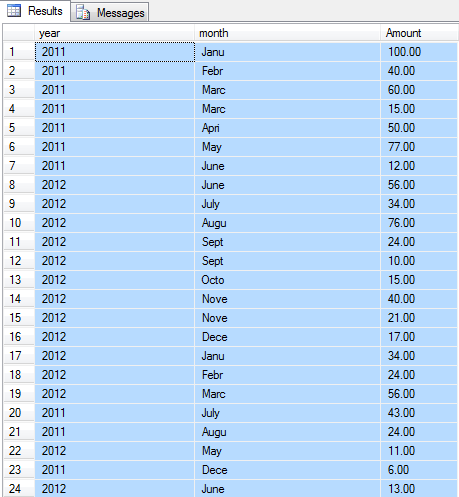Since Oracle 9i the FORALL statement includes an optional SAVE EXCEPTIONS clause that allows bulk operations to save exception information and continue processing. Once the operation is complete, the exception information can be retrieved using the SQL%BULK_EXCEPTIONS attribute. This is a collection of exceptions for the most recently executed FORALL statement, with the following two fields for each exception:
SQL%BULK_EXCEPTIONS(i).ERROR_INDEX – Holds the iteration (not the subscript) of the original FORALL statement that raised the exception. In sparsely populated collections, the exception row must be found by looping through the original collection the correct number of times.
SQL%BULK_EXCEPTIONS(i).ERROR_CODE – Holds the exceptions error code.
The total number of exceptions can be returned using the collections COUNT method, which returns zero if no exceptions were raised. The save_exceptions.sql script, a modified version of the handled_exception.sql script, demonstrates this functionality.
save_exceptions.sql
SET SERVEROUTPUT ON
DECLARE
TYPE t_tab IS TABLE OF exception_test%ROWTYPE;
l_tab t_tab := t_tab();
l_error_count NUMBER;
ex_dml_errors EXCEPTION;
PRAGMA EXCEPTION_INIT(ex_dml_errors, -24381);
BEGIN
-- Fill the collection.
FOR i IN 1 .. 100 LOOP
l_tab.extend;
l_tab(l_tab.last).id := i;
END LOOP;
-- Cause a failure.
l_tab(50).id := NULL;
l_tab(51).id := NULL;
EXECUTE IMMEDIATE 'TRUNCATE TABLE exception_test';
-- Perform a bulk operation.
BEGIN
FORALL i IN l_tab.first .. l_tab.last SAVE EXCEPTIONS
INSERT INTO exception_test
VALUES l_tab(i);
EXCEPTION
WHEN ex_dml_errors THEN
l_error_count := SQL%BULK_EXCEPTIONS.count;
DBMS_OUTPUT.put_line('Number of failures: ' || l_error_count);
FOR i IN 1 .. l_error_count LOOP
DBMS_OUTPUT.put_line('Error: ' || i ||
' Array Index: ' || SQL%BULK_EXCEPTIONS(i).error_index ||
' Message: ' || SQLERRM(-SQL%BULK_EXCEPTIONS(i).ERROR_CODE));
END LOOP;
END;
END;
/
SET ECHO ON
SELECT COUNT(*)
FROM exception_test;
SET ECHO OFF
The FORALL statement includes the SAVE EXCEPTIONS clause, and the exception handler displays the number of exceptions and their associated error messages. The output from the save_exceptions.sql script is listed below.
SQL> @save_exceptions.sql
Number of failures: 2
Error: 1 Array Index: 50 Message: ORA-01400: cannot insert NULL into ()
Error: 2 Array Index: 51 Message: ORA-01400: cannot insert NULL into ()
PL/SQL procedure successfully completed.
SQL> SELECT COUNT(*)
2 FROM exception_test;
COUNT(*)
----------
98
1 row selected.
SQL> SET ECHO OFF
As expected the test table contains 98 of the 100 records, and the associated error message has been displayed by looping through the SQL%BULK_EXCEPTION collection.
If the SAVE EXCEPTIONS clause is omitted from the FORALL statement, execution of the bulk operation stops at the first exception and the SQL%BULK_EXCEPTIONS collection contains a single record. The no_save_exceptions.sql script demonstrates this behavior.
no_save_exceptions.sql
SET SERVEROUTPUT ON
DECLARE
TYPE t_tab IS TABLE OF exception_test%ROWTYPE;
l_tab t_tab := t_tab();
l_error_count NUMBER;
ex_dml_errors EXCEPTION;
PRAGMA EXCEPTION_INIT(ex_dml_errors, -01400);
BEGIN
-- Fill the collection.
FOR i IN 1 .. 100 LOOP
l_tab.extend;
l_tab(l_tab.last).id := i;
END LOOP;
-- Cause a failure.
l_tab(50).id := NULL;
l_tab(51).id := NULL;
EXECUTE IMMEDIATE 'TRUNCATE TABLE exception_test';
-- Perform a bulk operation.
BEGIN
FORALL i IN l_tab.first .. l_tab.last
INSERT INTO exception_test
VALUES l_tab(i);
EXCEPTION
WHEN ex_dml_errors THEN
l_error_count := SQL%BULK_EXCEPTIONS.count;
DBMS_OUTPUT.put_line('Number of failures: ' || l_error_count);
FOR i IN 1 .. l_error_count LOOP
DBMS_OUTPUT.put_line('Error: ' || i ||
' Array Index: ' || SQL%BULK_EXCEPTIONS(i).error_index ||
' Message: ' || SQLERRM(-SQL%BULK_EXCEPTIONS(i).ERROR_CODE));
END LOOP;
END;
END;
/
SET ECHO ON
SELECT COUNT(*)
FROM exception_test;
SET ECHO OFF
Notice that in addition to the SAVE EXCEPTIONS clause being removed, the no_save_exceptions.sql script now traps a different error number. The output from this script is listed below.
SQL> @no_save_exceptions.sql
Number of failures: 1
Error: 1 Array Index: 50 Message: ORA-01400: cannot insert NULL into
("TIM_HALL"."EXCEPTION_TEST"."ID")
PL/SQL procedure successfully completed.
SQL> SELECT COUNT(*)
2 FROM exception_test;
COUNT(*)
----------
49
1 row selected.
SQL> SET ECHO OFF
As expected there is only a single error in the SQL%BULK_EXCEPTIONS collection, and there are only 49 records in the test table as the operation has rolled back to the preceding implicit savepoint.
As shown from previous examples, a move from conventional operations to bulk operations will require a revision of your current exception handling or the desired results may not appear.
The use of bulk operations with dynamic SQL is explained in the next section.
======================================================
SQL%BULK_ROWCOUNT
The SQL%BULK_ROWCOUNT cursor attribute gives granular information about the rows affected by each iteration of the FORALL statement. Every row in the driving collection has a corresponding row in theSQL%BULK_ROWCOUNT cursor attribute.

